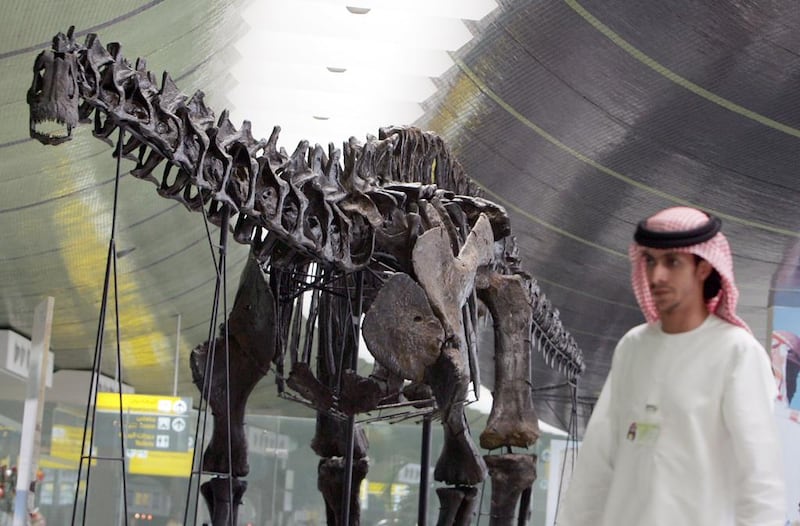The fourth Jurassic Park movie arrived in cinemas this past weekend, set in an open, functioning dinosaur park that realises the potential of Steven Spielberg’s 1993 film.
The original movie, based on the 1990 Michael Crichton novel of the same name, introduced the world to the idea of a vast adventure park full of roaming dinosaurs made possible by using the fearsome beasts’ DNA to create clones.
If such a park were to exist, no doubt the UAE, with its ever-growing, innovative tourism industry, would be involved. But very few traces of the animals have been found in the region.
Until the past 25 years or so, the Arabian Peninsula has had almost a blank slate for dinosaurs, and it was not until a 2013 paper that any fossils from the area were classified in detail as to the type of dinosaur they represented.
The study said that traces of dinosaurs in Arabia were “exceedingly rare”, in contrast to China and South America where there have been many amazing finds.
Dinosaur fossils are found in areas that have two things in common, says Mike Benton, a professor of vertebrate palaeontology at the University of Bristol, and author of such books as Walking with Dinosaurs: the Facts.
First, there are rocks of the kind that preserve dinosaur fossils, and second, these rocks are exposed on the surface.
In Arabia, desert conditions mean the second factor is often met. Unlike in Europe, rocks are not usually covered by farmland or forests. But the rocks often do not preserve dinosaur fossils because much of what is now Arabia was covered by sea during the time of the dinosaurs. Instead, marine creatures from that period are more common.
Around the world, dinosaur fossils are usually found close to where ancient rivers flowed and sandstone was deposited, with the carcasses having been washed down river and dumped on to sand banks.
“Some of the rocks on the Arabian Peninsula are the right age,” Prof Benton says.
“There’s a lot of Cretaceous but it’s mainly marine limestones, so it’s not the right environment for dinosaurs.
“There are a lot of other fossils like marine molluscs but you only rarely get dinosaurs being washed out to sea.”
The 2013 research on fossils from Saudi Arabia focused on dinosaurs that had died inland and were washed out by a river on to a beach.
Published in the journal PLOS One, the study involved material in north-east of the Red Sea from about 75 million years ago.
This was about 10 million years before dinosaurs became extinct at the end of the Cretaceous period, after an impressive 165 million-year stint on Earth.
Back then, this corner of Arabia was part of the north-east African continent but the Red Sea had not yet properly formed.
The scientists described seven vertebrae from a titanosaur, a type of large herbivore characterised by its long neck and small head. They also found two teeth from a theropod, a fearsome carnivore that walked on two legs.
The lead author of that study, Dr Benjamin Kear, of Uppsala University in Sweden, is now involved with the National Museum in Riyadh to help build a display focused on dinosaur material from the Arabian Peninsula.
“It would be good to have this major display, to see it really used to push the science forward,” Dr Kear says.
Among the other finds in Arabia was the 2008 discovery in Yemen of footprints from ornithopods, which were bipedal herbivores, and sauropods, a group that includes the titanosaurs. These were the first dinosaur tracks in the Arabian Peninsula described by science.
And in 1997, scientists described bones of sauropods and theropods that had been found about 50 kilometres from Muscat.
Another factor explaining Arabia’s relative paucity of dinosaur remains may be that parts of the peninsula have not yet been extensively studied by palaeontologists.
Dr Kear says there has been a long history of archaeological work in Saudi Arabia, but palaeontology, the study of forms of life on Earth from more than 11,700 years ago, is less developed.
“The main thing with the Middle East is trying in general to raise awareness about the importance and value of palaeontological resources,” he says.
Although Arabia has lagged in terms of dinosaur finds, Dr Anne Schulp, senior researcher in fossil vertebrates at Naturalis Biodiversity Centre museum in Leiden, The Netherlands – one of the scientists who described the footprints in 2008 – sees plentiful prospects for more finds in Oman and Yemen.
The poor security situation in Yemen will prevent work for the foreseeable future but Dr Schulp’s colleagues are planning fieldwork not far from Muscat.
And there are other finds from Oman that will appear in scientific literature in the near future.
Further afield, Iran has yielded dinosaur fossils, and Dr Kear is looking to study deposits there alongside local researchers.
The UAE has so far missed out when it comes to dinosaurs. Although fossils from Al Gharbia show the country played host to a fascinating and lush ecosystem that included elephants, hippos and monkeys, these remains are from about 8 million years ago, long after the dinosaurs became extinct.
Most of the exposed parts of the UAE’s geology represent sediments “much younger than the age of dinosaurs”, says Dr Schulp.
He says there are some areas near the border with Oman where late Cretaceous material is exposed, so dinosaur remains could one day be found in the country, although “the chances will be very few and far between”.
Even if the UAE never yields dinosaur material, we can expect more finds from neighbouring countries – a tantalising prospect for anyone interested in probably the most amazing creatures to have roamed the Earth.
newsdesk@thenational.ae







